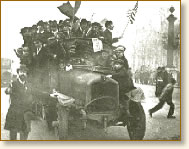Armistice
At 5 o'clock on the morning of November 11, 1918, a German delegation signed an armistice that would end the bloodiest conflict the world had
 |
Parisians celebrate the end of
the war November 11, 1918 |
seen. The ceremony took place in a railroad car parked in the French woods (22 years later, Hitler will demand that the surrender of France take place in the same railroad car at the same spot). The Germans had little choice. The allied armies had finally ended the stalemate of trench warfare and were advancing towards Germany on all fronts. Chaos reigned behind the German lines. Sailors of the High Seas Fleet mutinied while open revolt erupted at various points in Germany. The Kaiser had fled to the Netherlands as a socialist government took power in Berlin.
The terms of the armistice called for a cease-fire across the Western front to
begin at exactly 11 o'clock that morning. American Sergeant T. Grady described
that morning on the front lines, "Cold and raining. Runner in at l0:00 with order to cease firing at 11:00 a.m. Firing continued and we stood by. 306th Machine-Gun Company on my right lost twelve men at 10:55, when a high explosive landed in their position. At 11:00 sharp the shelling ceased on both sides and we don't know what to say. Captain came up and told us that the war was over. We were dumbfounded and finally came to and cheered - and it went down the line like wildfire."
Elsewhere Yanks and Germans met midway between their positions. Americans gave cigarettes, soap and rations. They received Iron Crosses, bayonets and even pistols. Then each group returned to their lines. The war that was to end all wars was over.
References:
Macdonald, Lyn, 1914-1918: Voices and Images of the Great War (1988); Marshall, S.L.A., World War I (1971).
How To Cite This Article:
"Armistice" EyeWitness to History, www.eyewitnesstohistory.com (2000).
Related EyeWitness Account:
Armistice - The End of World War I, 1918
History in Motion:
Film footage of soldiers celebrating at the Front
| 





